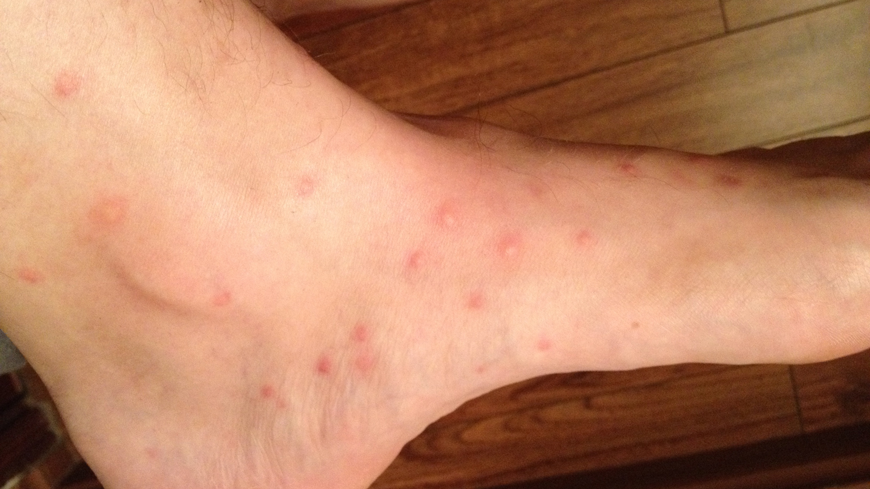
Img 1 Flea bites appearing as papules and reddening of skin. They appear in a cluster pattern.
Summary
Flea bites initially appear as areas of elevated skin. 24 hours later, the bites look like small welts. Skin around the bites may turn red. Flea bites often occur in clusters of three. Allergic individuals sometimes experience more extreme reactions.
Details
Flea Bite Stages
Flea bites vary in intensity, depending upon the affected individual and their degree of sensitization. Most insect bites follow 5 stages of sensitization, which correspond to previous exposure to the insect.
5 Stages of Sensitization
- Without previous exposure, there’s no sensitization. A bite won’t react.
- Subsequent bites cause delayed reactions after 24 hours.
- With more bites, both immediate and delayed reactions occur.
- Continued biting diminishes the intensity of the delayed reaction. Eventually only immediate reactions appear.
- In time, with more exposure, complete desensitization (immunity) is reached.
Sensitization in Humans
In humans, immediate reactions may not appear, but there’s almost always a delayed reaction. Young children have low levels of sensitization. As a result, they experience more extreme delayed reactions than adults. Gaining full immunity is rare, as stage 2 persists for at least 1.5 years.
Immediate Reactions
Whealing
Within 5-30 minutes, fleas bites cause whealing. Wheals are areas of elevated skin. Skin surrounding a wheal may turn red (solar erythema) as nearby blood capillaries dilate. The lesions have an irregular shape. The edges may not be clearly defined, or they may be outlined by a red halo. Wheals measure 2-10 millimeters in diameter. The surrounding redness can extend past 20 mm. Wheals quickly fade, so they don’t cause much irritation. Inflammation peaks within a few hours, and is gone 12 hours later.
Puncture Mark
Fleas are well-adapted for piercing skin. When feeding, they cause remarkably little damage. Hemorrhaging at the bite is slight or won’t occur at all. Puncture marks will be absent if a capillary wasn’t found. If present, a red pinpoint appears at the bite’s center. There’s a single puncture mark per bite, because the blood vessel is penetrated by one stylet. The mark is called the hemorrhagic punctum. It fades away over the course of 3-4 days.
Delayed Reactions
Papules
A delayed reaction develops 12-24 hours after the bite. Papules are the most common lesion. A papule is a raised, indurated (firm) area of skin, like a small bump or welt. A rash covered in many small bumps (maculopapules) is also common. Redness and swelling may accompany both types of lesions. Papules are 1-3 mm. The surrounding redness has a diameter of 2-20 mm. Sometimes a vesicle (tiny fluid-filled sac) develops in center of papules. The middle may also darken if the skin dies (necrotic centers). The lesions peak in size at 24 hours, and begins fading at 48 hours. They’re barely recognizable by the third day. A residual pale stain lasts for a week. Occasionally, the delayed reaction lasts longer. In rare circumstances, symptoms persist for a year or two.
Blisters
Flea bites rarely contain fluid. However, in extreme cases, delayed reactions can become blisters (bullous reactions). Initially, fluid accumulates under the skin in numerous vesicles. In 2-3 days, the vesicles grow and combine into a large blister, called a bulla. The reaction peaks at 72 hours. The tense blisters may be red or translucent, sometimes with reddening at their base. They often have a diameter of 3-6 mm. The blistered skin darkens as it dies (epidermal necrosis).
Extravasated Flaring
Another rare reaction is extravasated flaring. White blood cells move from capillaries to the tissue around the bite. This results in inflammation. Dark, red, splotchy skin is concentrated at the bite location and spreads outwards.
Rashes
Flea bites sometimes appear as hemorrhagic macules, which is a type of rash. The afflicted area gets speckled with red, discolored skin..
Inflammation
Scratching a flea bite causes inflammation and increases the sensitivity of nerves in the area. Inflamed skin and scratch marks will appear bright red or pink.
Secondary Infections
Flea bites are extremely itchy, which creates an urge to scratch the lesions. Scratching a bite can break open the skin, release fluid, and cause crusting. Secondary bacterial infections aren’t uncommon. Infected bites become filled with pus, taking the form of pustules or boils. They resemble pimples. The lesions heal over 4-6 weeks, but skin remains discolored for longer.
Flea Bite Pattern
Flea bites often arise in clusters of three, all within the area of a few centimeters. The bites may be arranged in a line or triangle. The pattern is called breakfast, lunch, and dinner or meal cluster.




You must log in to post a comment. Log in now.